“Because dark energy makes up about 70 percent of the content of the universe, it dominates over the matter content. That means dark energy will govern expansion and, ultimately, determine the fate of the universe.” -Eric Linder
It's been a while since we've spoken about dark energy, and we were just talking about Einstein's greatest blunder, so let's just dive right in.
This is our observable Universe, as unveiled by the Hubble Space Telescope. With hundreds of billions of galaxies stretched out some 41 billion light years in all directions, finding out about what our Universe was like in the distant past, the recent past, and what it's like today is limited only by our willingness to look. In particular, there are three great sets of observations that tell us ever so much about the Universe on the largest scales.
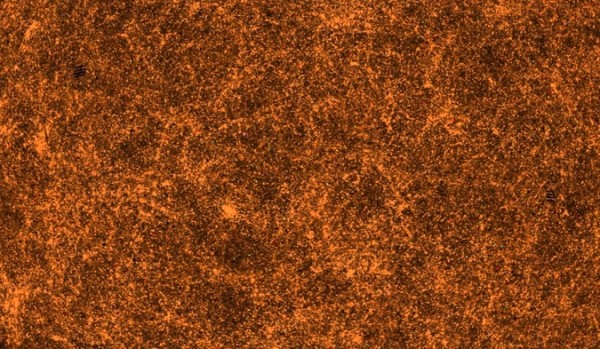 Image credit: Northern Galactic Cap from the SDSS-III release, via http://www.sdss3.org/.
Image credit: Northern Galactic Cap from the SDSS-III release, via http://www.sdss3.org/.
1.) The way galaxies cluster together on the largest scales. By looking at huge, tremendous surveys of galaxies, we can see how the visible matter in the Universe has clustered, clumped, and grouped together, as well as where it hasn't, and has left us great cosmic voids. By putting various ingredients into a model Universe governed by General Relativity, we can also simulate how structure should form in our Universe. Where the simulations and the observations match up, that tells us what's in our Universe.
2.) The temperature fluctuations in the cosmic microwave background. By looking at the temperature fluctuations -- the hot-and-cold spots -- in the CMB, we can know what the Universe looked like in terms of overdensities, underdensities, and how they're clustered with respect to one another all the way back at a time when the Universe was just some 380,000 years old! Because the light has had to travel for nearly the entire 13.8 billion years that the Universe has been around (it's been traveling for 99.997% of the Universe's history), we can find out information about what the Universe was like back then, but also how it's expanded since then. This pattern of fluctuations also tells us what the various combinations of ingredients are in our Universe.
3.) Direct observations of well-understood objects at various distances/redshifts in the Universe. Everything from variable stars to properties of galaxies to distant supernovae help us get a handle on this, the cosmic distance ladder. This tells us how the Universe has been expanding since as far back as we can measure until the present day.
When these three data sets are combined -- and we can combine others, too, but these three are the best data sets we have -- they tell us that there's matter in the Universe, about 31-32% of the Universe is matter (most of which is dark matter), and that there's another type of energy, dark energy, that makes up the rest.
So, you ask, just what is dark energy, and how do we know?
In principle -- and by in principle, I mean in General Relativity -- matter, energy, topological defects, and pretty much anything else that you throw into your Universe is going to affect how your Universe expands because of two properties inherent to it: it's energy density and its pressure.
Because of the way the Universe is observed to expand, and because of the known way that matter (yes, even dark matter, according to General Relativity) behaves, we can infer something about the energy density and pressure of dark energy. In particular, we know that dark energy's pressure is negative, and that it's quite negative.
In General Relativity, we can relate the pressure of any component of the Universe to its energy density by the simple equation:
ρ = w P / c2,
where ρ is the energy density, P is the pressure, c is the speed of light, and w is just some number.
According to the best data we have right now, w is equal to -1. Now, as time goes on, we hope to constrain it better; we can say it's probably about -1.00 ± 0.08 right now, which is pretty good.
Now, here's the thing: in theory, the pressure of different things in cosmology goes in increments of 1/3. For example:
- Radiation has w = +1/3, like photons and ultra-relativistic matter.
- Matter, both normal and dark matter, has w = 0, or is virtually pressure-free.
- Cosmic strings, or 1-dimensional topological defects, have w = -1/3. This is the border between what would cause a Universe to accelerate (more negative than this) or not.
- Domain walls, or 2-dimensional topological defects, have w = -2/3.
- A cosmological constant (or textures, a 3-d defect) has w = -1.
Those are the easy possibilities.
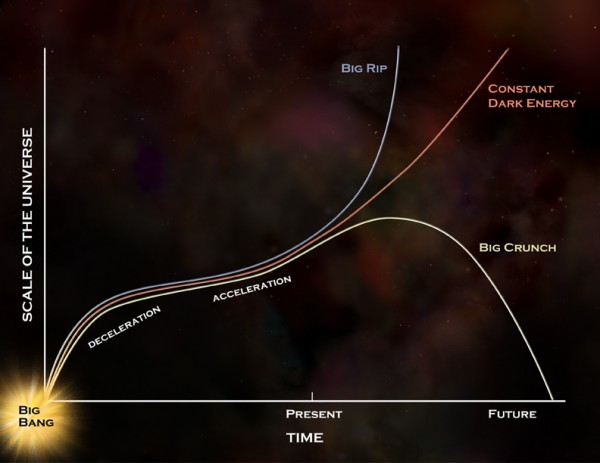 Image credit: NASA / CXC, via http://chandra.harvard.edu/.
Image credit: NASA / CXC, via http://chandra.harvard.edu/.
But dark energy could also be something weird. It could be a field, whose relationship between pressure and energy density changes over time. It could be coupled to something we don't understand. It could be really, really weird, and our measurements of w = -1, to the best we can see, could only be what the Universe is so far.
So we've attempted to look for a change in w over time. We've attempted to look for departures from w = -1. We've attempted to look at different models and their signatures.
Know what we've found?
The farther back into the past we look, the more and more consistent everything appears to be with the cosmological constant option.
The cosmological constant option has the theoretical bonus of being:
- easily explained,
- inevitable (in that it must exist, even though its value could be 0),
- and requires no new physics beyond the standard model/GR to explain.
We're going to keep exploring different variants of dark energy, quintessence, scalar field-driven dark energy, etc., of course. But theoretically, there's no motivation unless we see some sort of evidence that tells us that dark energy is something more (or other) than a simple cosmological constant. And trust me, we're looking.
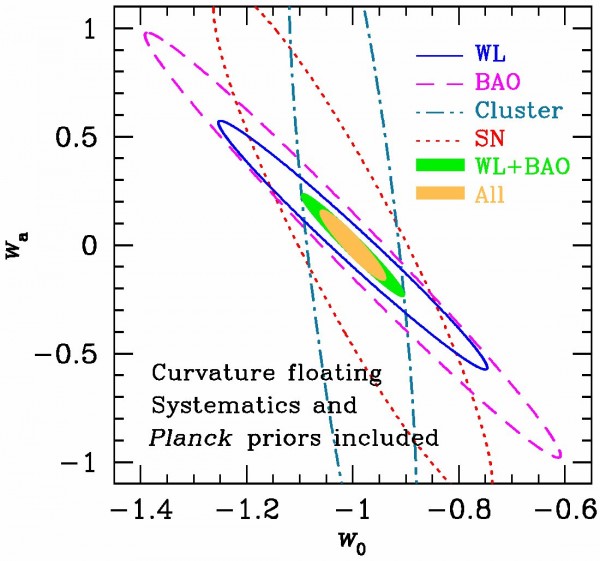 Image credit: LSST and others, via http://www.lsst.org/lsst/science/scientist_dark_energy.
Image credit: LSST and others, via http://www.lsst.org/lsst/science/scientist_dark_energy.
This doesn't mean dark energy is a cosmological constant, it just means that this is the best working hypothesis until evidence suggesting otherwise comes along, and such evidence does not exist today. That's the best we've got, so far.

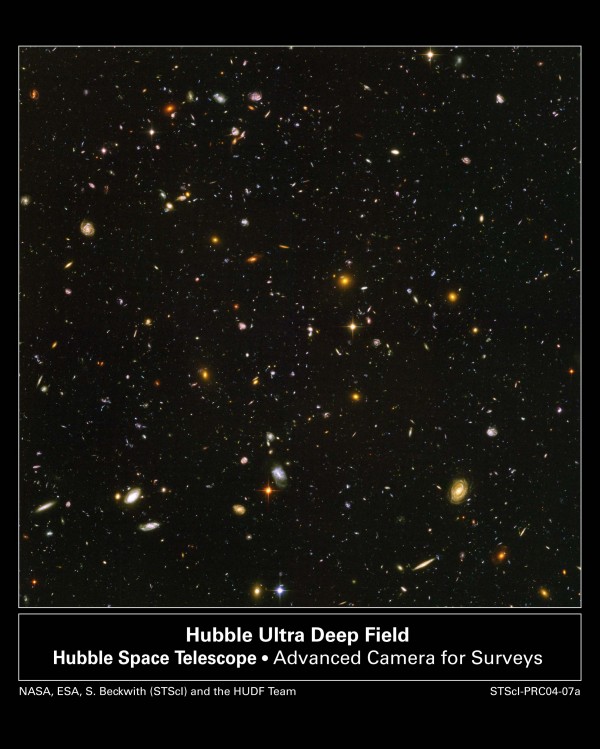
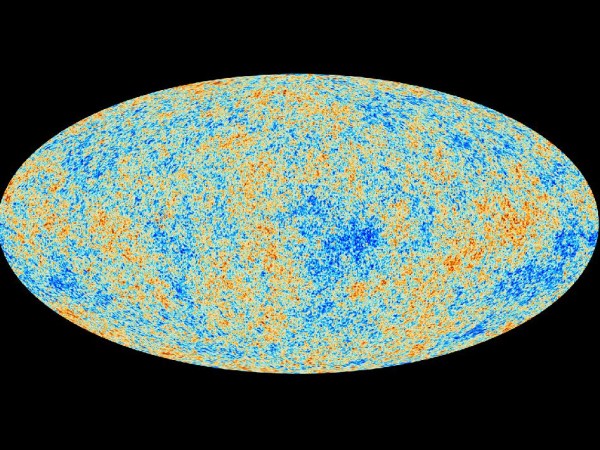
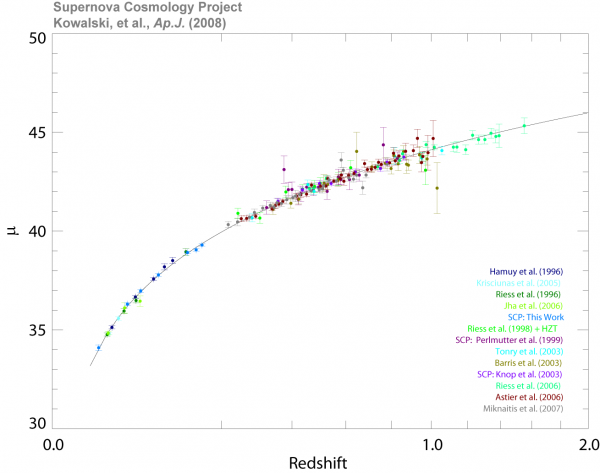
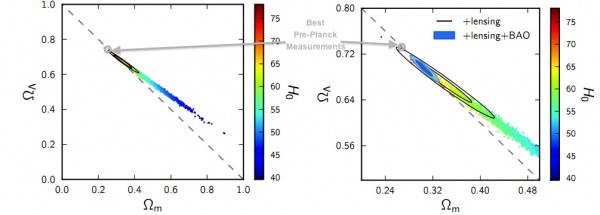
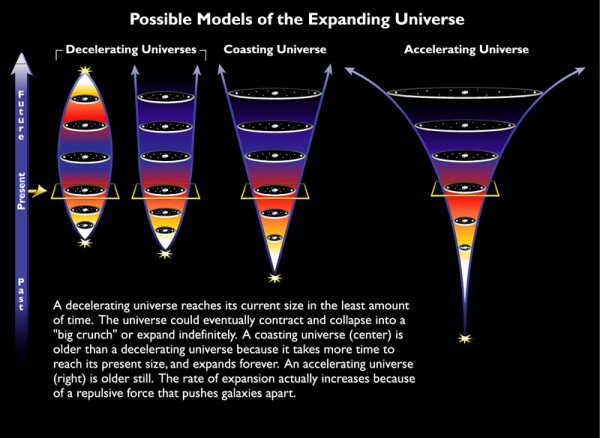
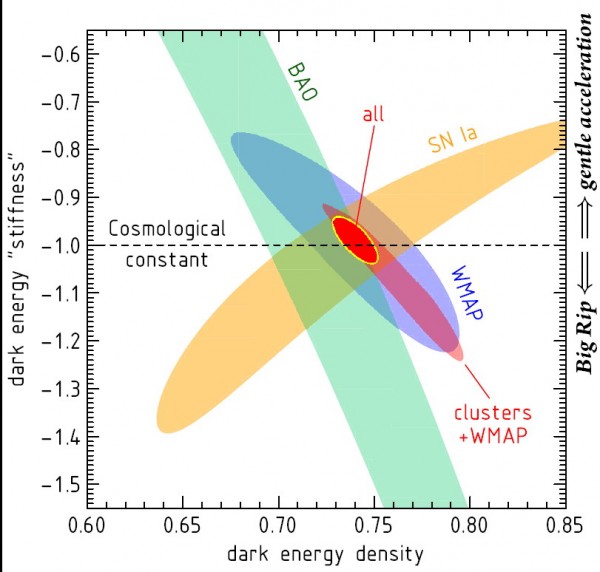
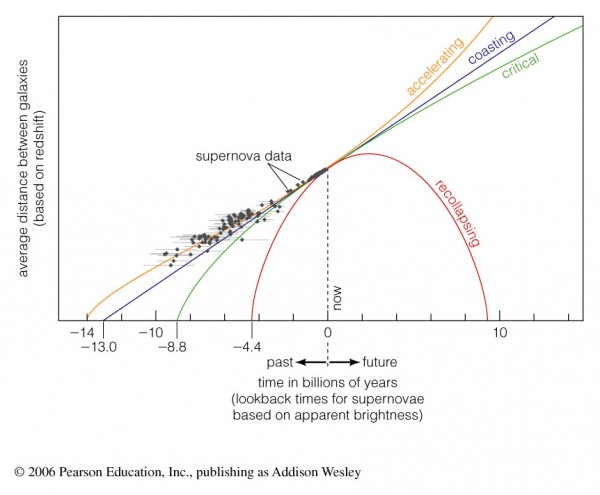
What is the best example of non-dark energy, and what is it's proportion of the contents of the universe?
Every bit of regular matter(electromagnetically visible) in the universe is, I believe, an example of non dark energy. After all E=mc^2!
So, with all that sai, what IS dark energy?
@Rob:
" ...there’s no motivation unless we see some sort of evidence that tells us that dark energy is something more (or other) than a simple cosmological constant."
This is the best answer (at this point in time) based off the best data we have.
All that was a very good explanation bringing the important facts together.
But could you explain on thing.
As I understand it. I thought that Quantum Field theory predicted an energy density of the universe that is 10^120 times bigger than observed. And this error has been called the biggest error in physics. etc.
My question, and it's not an argument is. Can someone simply explain how the error of 10^120 times comes about and what it means in QFT or whatever theory it is from.
I know its a big number and I know physicists say that it is obviously wrong. But I want to understand the physical idea behind that error. I mean QFT is a very useful theory. So even if the number is totally out there. And it is. There might be some valid physical interpretive meaning to the number.
Am I making any sense? Please educate me thanks.
But Ethan, I liked your explanation a lot; because it focused on the essentials, the range of ideas being explored and observations.
Normally, I just go byserk about an enormous crazy number; but in this case 10^120 error; I'm looking just to understand the what the QFT story was. Here's what this is suppose to tell us. here's what it said. Here's how we should be able to interpret it. But it is so far off from what we measure that.
Please educate me, send me a link. anything thanks.
"I thought that Quantum Field theory predicted an energy density of the universe that is 10^120 times bigger than observed."
No, that's a strawman creation there, OKThen.
A proposition was that the quantum field could be a source for dark energy, but that if the 4-dimensional universe were all we had, and it was all used, then that would be 120 orders of magnitude bigger than seen.
It's like saying "Since E=mc^2, and nuclear reactions convert mass to energy, then a nuclear bomb should return 100x as much energy in an explosion as we see it doing".
The problem with the illustrated version is that the assumption that all mass is converted.
So all that needs be done is find a way that can be verified that explains why only a tiny fraction of the quantum field energy is *expressed* as dark energy.
"all" of course being rather a small word for how much work is involved..!
Pretty scary to imagine that we live in a universe we can only see about 5% of the material that surrounds us. And I guess this must hold in our solar system, too.
http://www.uws-science.de/
Nice post Ethan. But not sure we are any closer to the answer from the title. What is it?
So here are my 2 cents. What we do know from observation is that at some point 5-7 bil. years ago expansion started accelerating. What we do have as far as theory is friedman equations where if we put in energy density+matter density+lambda+curvature we ought to get 1. When we measure matter, it comes nowhere close to 1. Curvature is 0 as far as we know, so that leaves lambda and energy. Energy is taken to be 0 at current time. So that leaves matter + lambda = 1.
What we don't know, as far as I can tell, is what lambda is (other than a letter in a formula). The only possible source we have so far is vacuum energy. But what do we know about vacuum energy? Very little to none it seems.
If using simple logic and QM, one solution to vacuum energy is that it's infinite. Take every point of space, say that it has some small value, then add all points together... infinity. Thus QM says that only CHANGE in vacuum energy can be measured or quantified. Not really what cosmology wants. Other way to get some value is to use "guessing" and go with planck units. Then we get a pretty big value for every planck volume of space. Neither of these works with what cosmology needs.
Ok, so let's leave cosmology for a while and stay with QM. What can we infer about vacuum energy from QM. Well, not much. For one, since only change can be measured, and if nothing changes, QM just puts vacuum energy value to 0 and doesn't even deal with it. Other clues we can maybe get from experiments. The Cassimir effect and few others. But this puts forth new problems. For one, if Cassimir force is due to vacuum energy, this value is much bigger than what cosmology needs, secondly, Cassimir shows effects with charged objects, and lastly, perhaps most importantly, there have been papers showing that Cassimir effects can be explained and calculated perfectly well with "regular" QFT without the need for vacuum energy.
To settle this, I'm guessing more particle physicists need to get involved with vacuum energy, currently there doesn't seem to exists a desire to tackle that.
So what do we know from cosmology? According to Sean Carroll, Michael Turner and others, looking at supernova data, it is very indicative that acceleration started at one point several billion years ago. In other words, it's not a constant factor from the beginning of the Universe. As far as I understand there is an issue with early structure formation if there was a negative pressure pushing matter away at those early times. Secondly, they say that there is some evidence that before that acceleration there was a period of deceleration. Also, due to redshift effect being observable only from 0.2-0.3z onward.. or some several hundred million light years, we don't really know what the Universe is doing at the moment. If we look only at the data, we can't tell if the Universe is accelerating or decelerating today.
So from all of this, IMO, our current understanding of vacuum energy is a poor fit for cosmology. Cosmology needs a field that behaves like vacuum energy but isn't it. If observational evidence isn't biased, then that field also needs to fluctuate with time, something no lambda model really does.
So to sum up. IMO, there are 2 big questions for the future of physics and astrophysics in this field. For QM - is there an observable vacuum energy in our Universe, and what's it's value. For cosmology - is vacuum energy of QM really the same thing as Lambda. If it's not, then what is it?
Hope some interesting thoughts come to this blog as well :)
@5 OKThen
QFT doesn't give an energy density of the Universe. It "could" give the energy density of vacuum. Universe and vacuum aren't the same :)
QFT in fact doesn't give the value at all. It just says that vacuum isn't empty but that there are fluctuations.
If you go only by this, the answer is infinity.
Second way is to NOT assume spacetime as a continuum and only use vibrations larger than planck length. Then you get something like 10^96 kg/m3 equvivalent to E=mc2. Put that in planck units and you get 10^120. That's where cosmological constant problem comes from.
There are further complications to even this mess. One is that this way of calculating is consistent only with free fields (no interactions between modes). Reality is not such.
Second, and much more important, is that nowhere in this is there gravity. And without that, the most honest answer is, you can't calculate the value of energy density for vacuum.
Ethan
You put wonderful illustrations and graphs of data. But you don't really talk about the data plots - define the variables. For instance, in your last graph Wa vs W0 is plotted. So I can guess that W0 is darkenergy value of W because its -1. But what is Wa. You obviously are trying to communicate to non-specialists in your field. Unless the data plots are just to impress then an actual discussion that helps the audience understand what they are looking at would be very useful to that communication
"The cosmological constant option has the theoretical bonus of being: easily explained"
I hope that's next?
See the wiki cosmological constant article. It's is the "energy density in otherwise empty space". Then see the wiki stress-energy tensor article. Look at the diagram on the right. See that shear stress? Google "shear stress elastic" and "tensor elasticity". The stress-energy tensor is kind of modelling "elastic space". Imagine the universe is a stress ball. Squeeze it down in your fist, then let go. Note though that dark energy is usually described as the thing that causes the increasing expansion of space, not the expansion of space. That doesn't account for "the strength of space" reducing as the universe expands. See Webb’s http://arxiv.org/abs/1008.3907 re variations in the fine-structure constant along with Milgrom’s http://arxiv.org/abs/0912.2678 for mention of “modifying the ‘elasticity’ of spacetime (except perhaps its strength), as is done in f (R) theories and the like”. Get some silly-putty, stretch it out and watch it droop faster and faster.
Einstein The stress-
@11 Ben
the meaning is that cosmological constant = vacuum energy. Mathematically that is. Space has inherent energy density. That's the explanation.
p.s.
the reasons are simple. It's obvious that universe is/was accelerating. Not just expanding. Einstein's equations without lambda give unstable universe.. either expanding or contracting. But that's not enough, now you need something to accelerate expansion but also add a huge missing energy. Cause if it had regular (positive pressure) if it just add to gravity not oppose it.
Now you look at what there is.. and only thing we have theoretically is vacuum energy. Which doesn't really fit for now, but has right properties.
There is something out there, and there's very lot's of it :) That's for sure.
It might be many things that contribute to DE in the end. Maybe one day we find the value of vacuum energy, and it's let's say several orders of magnitude greater than what DE needs, but along the way we find other contributing factors. We learn new physics. :)
Wow and Sinisa Lazarek
Thank your for those answers. they help but I am still confused.
So let me paraphrase and maybe you can tell me what I am misunderstanding.
So I'm going to assume that the strawman was to use something like Sinisa's "Second way is to NOT assume spacetime as a continuum and only use vibrations larger than planck length. Then you get something like 10^96 kg/m3 equvivalent to E=mc2. Put that in planck units and you get 10^120. That’s where cosmological constant problem comes from." And that the reason this was a strawman was that there really was no good reason to limit the calculation to vibrations larger than Planck lengths.
Thus the 10^120 answer was not any kind standard way of renormalized to get correct answers (that matched with experimental observations in many situations, such as Feynman and others invented). It was a one of a kind for no good reason normalization; and thus 10^120 was not a much better answer than infinity.
So let me paraphrase a different way. And I may be inconsistent and misrepresenting what you are saying. So just knock me on the head.
It seems that both of you are suggesting that vacuum energy is as far as we can calculate or assume from QFT essentially or potentially infinite. But DE is the only thing that we can measure (i.e infer from observations) and it is a tiny tiny amount of that vacuum energy. In the same sense that a nuclear fusion bomb only converts a very tiny tiny bit of the mass of the bomb into the energy of the nuclear explosion. I guess I never thought about how efficent the energy convertion of a nuclear bomb or a star is. But OK.
Well that's all. Both your explanations help. But I'm not sure if I understand yet. Thanks for any further comments and clarifications. I got no more questions; just listening. Thanks.
@Sinisa #15
I like that very last point. It is really easy to just assume Dark Energy is just one specific thing. Dark matter I feel also falls into this category. Simplicity is awesome but I feel in all likelihood both will be far more complex than just one energy and one evasive particle. Hell just look at the Standard Model for our lowly 5% of the universe. If it is that complex we might be screwed trying to fathom the other 95% haha.
"So what do we know from cosmology? According to Sean Carroll, Michael Turner and others, looking at supernova data, it is very indicative that acceleration started at one point several billion years ago. In other words, it’s not a constant factor from the beginning of the Universe"
Isn't this just the result of dark energy, which if a cosmological constant has constant density, being overwhelmed by gravity early on, then dominating gravity once the universe had sufficiently expanded?
"It was a one of a kind for no good reason normalization; and thus 10^120 was not a much better answer than infinity."
Actually, that's infinitely better than infinity.
Indeed, it's so much an improvement over infinity, even as orders of magnitude, that it would be no improvement to get it down to a factor of 10^0.
Infinity is odd like that :-)
@ OKThen
"there really was no good reason to limit the calculation to vibrations larger than Planck lengths"
- well the only reason was to try to get something else then infinity. :)
"Thus the 10^120 answer was not any kind standard way of renormalized to get correct answers"
- well, there is no standard way really. The 10^120 is what you get in "natural" units (just a human term)... h bar is 1, c is 1.. if you take volume of space of planck length (very small) and take 1 planck mass (which is small, but huge in comparison with planck lenght.. micrograms), you get 10^120 as energy density of vacuum. One thing that probably isn't correct is our assumption of plank mass... but still, where's the error?
"It seems that both of you are suggesting that vacuum energy is as far as we can calculate or assume from QFT essentially or potentially infinite."
According to wiki and other places, it's actually 4 different answers at the moment
1. infinite
2. 0
3 10^120
4 undetermined (waiting for quantum gravity)
@CB
In one of their papers, to my understanding, they tried to probe the data without using friedman's equation. In a way, not assuming anything about equation's of state. It's not that they didn't arrive to similar results, but there seems to be more than just it.
http://arxiv.org/pdf/astro-ph/0512586.pdf
found it to be interesting
additional reading :)
http://relativity.livingreviews.org/Articles/lrr-2001-1/download/lrr-20…
http://arxiv.org/pdf/0803.0982.pdf
Wow and Sinisa
Thank you so much.
That does put it in perspective.
If I may say so, it is good to more clearly understand what you don't know. And now, I more clearly don't know.
Thanks.
Sinisa
Thanks for the calculation examples, especially the natural units one.
@crd2
I did read the part about dark energy being a simple cosmological constant. But if the evidence is that 68% to 69% of the universe is dark energy, then this is saying "68% to 69% of the universe is a simple cosmological constant," i.e., a dimensionless number. I'm sorry, but this is nonsense.
I don't know much physics, but I always wonder how well the experimental value of the vacuum energy (based on the Cassimir effect) fits the theoretical value that dark energy should have...
Also, if it's energy, shouldn't it have associated a gravitational field which, I asume, should be responsible for the acceleration of the universe?
Can anyone clarify me this, please? Thanks!
Dark Energy is a negative term in the gravitational field, therefore it doesn't ADD to the gravitational attraction of a location, it subtracts it.
How does it do that? Nobody really knows. There are some theories (in the layman terms, though some have more explanation than others, meaning there's more that could be tested about it than others).
Instead of a Jovian pronouncement, how about you explain why it's nonsense?
"And now, I more clearly don’t know."
Well, my last one wasn't really adding to what you DO know, it was just something I find eternally amusing (and feel relief I didn't do maths at university).
Hell, Dark Energy could be the same "phase change" that is proposed for explaining the early massive inflationary period of the universe: if it hadn't been 100% completed everywhere at the same time, then maybe this is still some "settling out" of that source of energy.
NOTE: probably 99.9999999% likely to be Bullshit, but I use it to illustrate *to myself* what answers are possible. If someone better at this than I picks the idea up and, wonder of wonders, it works, then they deserve the entire plateful of kudos for doing so. If they show that causality-wise this is not possible a priori, I will be 0.0000% surprised.
I've nothing invested in the idea. Idle speculation by someone too lazy to do the work themselves :-)
Wow I was just making fun at myself.
You and Sinisa helped a lot. You put things in perspective so I understood what was being talked about and why. I mean if I don't even understand the discussion; then I got nothing to ponder. Thanks, I learned something.
@Sivainvi #24: energy doesn't cause gravity if it's uniformly distributed. Imagine you're in a void at the centre of the Earth. You don't fall down, you just float around. It's the same kind of thing for the innate dark energy of space. You need a gradient in energy density for light to curve and for things to fall down. But check out the stress-energy tensor on wiki and look at the picture on the right. See the diagonal this way: \ featuring energy and pressure. If you've got a uniform energy density in space, it can act like a fundamental pressure. Hence space expands. For an analogy, squeeze a stress-ball in your fist, then let go.
OKThen, I wanted to illustrate that I can hold an idea that is plausible *to me* but consider it not worthy of defence *unless* I'm ready to put the damn effort in to work it out.
If I came up with something that drove someone else to find something new *I would be *ECSTACTIC** I wouldn't consider it mine.
Well, except to whinge about how "I was robbed" :-)
Because I wasn't willing to do the hard work of checking. So the best I can hope for is my ideas inspire.
If I cared enough, I'd damn well do the work. If I can't then someone else can look at my apathy and *absolutely* decide that it isn't worth looking in to.
Even if someone else may decide "That's interesting, someone should look into that".
If they said "I'll look into that", that's different. And they deserve the accolades (because I'll leave them with the shame).
Short version: If you're convinced you have it right, then you either do the work to prove it right or accept you're not able to show that it IS right.
@24 Sivainvi
you can check on wiki for more details. But if I remember correctly cassimir force gives something around of 1bar of pressure for atomic scale volumes. That's huge!
Wow #30
I agree with a difference.
I think inspiring is a most important contribution to the science discussion. And I don't just mean casual discussion. I think of all those thousands, maybe hundreds of thousands of papers of excellent research; that may never achieve recognition of being a textbook footnote or even cited. And yet that research may be part of a seed or maybe part of a new ecology of ideas that grows into a strong science.
And then I thought of the idea of emergence and wondered where it started? "The term "emergent" was coined by philosopher G. H. Lewes." "George Henry Lewes (18 April 1817 – 30 November 1878) was an English philosopher and critic of literature and theatre." wikipedia
Well it seens like G. H. Lewis, whom I've never heard of, did some important inspiring.
Well done, keep inspiring!
After some research, think we can just use one name for DE and throw away the rest. The name? Inflaton.
Not cosmological constant (since it's not that) but instead a scalar field. One and the same field that caused inflation, caused re-heating, and has now settled to a non-zero value (or lowest energy state).. or maybe just another flat region before another drop.
So why not drop Dark Energy, Lambda, Cosmological Constant, Vacuum Energy, Zero point Energy and the rest, and just use one name? Inflaton scalar field with an associated boson particle.
We don't even know that there is an associated boson with it yet.
I think that calling it dark energy may be good copy, but not really worth it as well.
@ Wow 34
"We don’t even know that there is an associated boson with it yet."
But a quanta of a scalar field in QM is by default a boson. No?
The force carrier would be a boson, but that is only currently required because the models we produce for forces require something to carry the momentum that causes the change in momentum between two affected parties.
Gravity, if considered a curvature of spacetime requires no force carrier, as an example.
I see what you mean.
What I was saying is that if you accept inflation theory, then you already have a scalar field associated with it. So there's no need to invoke new names and labels (to energy) to further complicate things.
Just call it inflation.
Though it's probably far far too late to get that changed. In science papers they'll use either depending on what they're trying to do with it, which is likely the correct way of doing it, but this will continue to be misheard (much like "the earth isn't a greenhouse, therefore greenhouse gasses do not keep the earth warm!").
(Insert the usual disclaimer here about "this might be pure ignorance speaking, but...")
The term DE is literally true, in the sense that "dark" means "not yet directly observable," and "energy" means "a force that performs work." But I tend to think of "dark energy" as basically a useful approximation for one or more phenomena we don't yet understand. Not a fudge-factor, but a temporary placeholder that lets us develop useful hypotheses and proceed with useful calculations. As in, "this isn't quite right, but it'll do for now, and it lets us get closer to real answers."
Science works its way iteratively toward convergent solutions, and it's OK to be living at a time when we're iterating toward answering fundamental questions. Those who are willfully ignorant (as opposed to being merely ignorant;-) will assert that "science doesn't really know anything," which only illustrates the need to properly educate the public. Personally I find it exciting and awe-inspiring to see progress on these things occurring in my lifetime.
---
I'll disagree with Sinisa at #33, and say that these various terms are each useful in different contexts and for different purposes. For example zero-point energy was originally a theory intended to explain inertial mass: and that doesn't strike me as interchangeable with DE either in theory or in terms of potential observations. The Cosmological Constant was used by Einstein to deal with some unpleasant consequences of his own math, and it happens to coincide with a hypothetical effect of DE that's a placeholder for explaining accelerating expansion.
Eventually we may get to a point where some but not all of those terms are rendered redundant, but I don't think we're there yet, or even close.
Or we'll wake up one day to a voice coming out of all of our radios and TVs, saying "This is God speaking. I'm rather pleasantly surprised that you managed to find the contradiction in my most recent universe. I'll save you some effort by admitting that, yes, it was a mistake on my part. But I'm working on creating another one that doesn't have that problem...";-)
@39 G
My main reason for wanting to throw away different names is because in terms of physics they describe different things. If you go only by this, you can soon find yourself dealing with 3 or more different things saying they are DE. So the first order of business IMO would be to see if we are dealing with one phenomenon or more of them.
Now, the conclusion which I arrived to (and mind, it might be totally wrong) is that it's not at the moment 3 different things, but only one (inflation field).
Inflation field is a scalar field. It's potential changes with time. And it's energy density is given by scalar field equations. Of course, this field hasn't been observed or detected, but if you accept inflation (and cosmology accepts it), then you have a filed associated with it. And in fact it is this field according to cosmology that gave the energy to make the matter and the rest of standard big bang.
Now, cosmological constant is not this. It's not a scalar field, it doesn't vary with time.. it's a constant. But this doesn't work. It doesn't match our observation. It's a historical relic. If you say that DE is a cosmological constant, and you don't say that you actually mean the inflaton field... then to someone listening you are talking about two different things. One is inflation energy, and the other is this constant. And this is not what current cosmology thinks.
Similar thing is with vacuum energy. Now there are places where actual vacuum energy is addressed in cosmology, particularly with CMB. The fluctuations are frozen in by inflation, and that pattern is what we now see in CMB. But inflation field is not vacuum energy. Because overall vacuum energy can still be 0 or infinite. It's the waves that get blown up by inflation.
So, my reasons are that if you use Dark Energy (just like with dark matter.. you are refferencing something unknown, undetected, which can be anything). If you say inflation field, this is a known thing. At least in theory. It has certain properties, it has certain history, and you can compute some things. You are talking about something particular. Just like higgs field i.e. It's not mysterious any more.
If you use lambda and cosmological constant, sooner or later, if you want to stay consistent with cosmology, you will have to say that it's not a constant actually, and that it wasn't always the same. And it's very different from original lambda. The problem is that you can't use equations of state for pure lambda once you start dealing with early universe. You have to use inflation equations. That's why I think cosmological constant is misleading.
To astrophysicist this might not be a big deal. But like I said earlier, to a layperson, it gives very wrong notions of what things are, what is know and unknown, and how things work.
So that's pretty much my argument :)
S.
Re. Sinisa at #40: OK, and I agree with what you just wrote there. If I understand what you said: Each of these terms refers to something different, and it's important to not confuse them or use them interchangeably in a manner that's confusing.
I tend to think of "inflation" as a theory to explain certain observations such as the red shift. As a layperson I hadn't thought of it as a field, I thought of it as a force. Though if what you said about that represents the scientific consensus, then I just learned something.
I think of the cosmological constant as I described previous: a mathematical term used as a temporary placeholder for practical reasons.
I don't confuse vacuum energy with either of those, because I got my intro to that subject from Bernie Haisch (one of the folks who developed the theory) while installing the PBX at his office in Palo Alto years ago (I'm a PBX engineer).
I got my intro to DE (and dark matter) from the part of the science press that's accessible to laypeople, and have kept an eye open for any new findings in this area since it's one of the major puzzles of our time.
So in general I don't confuse those things with each other, with the exception of having confused DE with the cosmological constant until recently (thanks to Ethan et. al. on this specific blog, for having clarified that one).
The fact that sources such as this exist, is highly useful for educating laypeople (such as myself), via the opportunity to ask questions, speculate on ideas, and engage in discussions with working scientists and science educators.
The fact that the CC is not constant throughout the history of the universe, is interesting, along with the fact that inflation is a relatively recent development in the history of the universe. The idea that the progression of cosmic events has some significant departures from uniformity, is one of "those things," like Einsteinian relativity and Heisenberg uncertainty, that appears to contradict the "common sense" layperson's Newtonian view of reality, and one has to "get used to it" over time. But eventually one does get used to it, and even slightly conversant in it. Nature usually turns out to be more interesting than we expect;-)
@G
"As a layperson I hadn’t thought of it as a field, I thought of it as a force."
well.. if you plot force in every point of space you get a field :) It's the same thing.
Magnetic force... magnetic field. Gravitational force... gravitational field.
The difference with inflation is only that it's a scalar field, not a vector field.
Hi Sinisa-
Now I'm really feeling like a second-class idiot!;-)
What you just said: "If you plot force in every point of space, you get a field."
Bloody hell, I should have been able to figure that out on my own years ago, but, nope!
Yes, I think I understand the difference between scalar and vector: a vector is a quantity with direction, a scalar is a quantity without direction. (Now watch, I may have just blown it again;-)
What's funny as hell is that I can describe certain phenomena is pretty decent detail for a layperson, and even come up with analogies that are correct (e.g. "attempting to use entanglement for communication is like receiving a ciphertext via email and having to wait for the decryption key via postal mail"). And yet, the gaps are large.
Anyway, thanks for filling in one of those large gaps.
Hey, at least I'm trying;-)
Thanks again...
no prob :) glad to help, for me also every day is something new.
So I'm confused. We have a universe which continually expands at an acceleration rate? so are we the yellow accelerating line? big rip on the other? on the And how does this at all relate to the shape of the universe, i.e it being "flat', as I've heard others mention. It's all confusing. could someone please help explain this?
Assuming you're talking about the 7th image with the illustration of the size of the universe over time, we're the last one. The little yellow square represents the present which bisects the universe size lines to show the "extent of the universe" at the present time.
A "big rip" is our distant future. Well, by "our", I mean "the fate of the universe", we'll be long dead by then, indeed well before a big rip, the universe would not be able to support processes as entropic as life.
The "flat" universe comes from when we didn't have any computing power to do the calculations for anything other than a very VERY stripped down GR equation for the universe. It doesn't really pertain to the current knowledge, since we can do the calculations with a less stripped down version.
"flat" is working with an idea nearly a century old now. If you find it confusing when allied to more modern framing, then ignore it.
@WOW #26.
Sorry, I didn't see you'd replied. I think it's nonsense in that, to be what constitutes 68% to 69% of the universe, the number must represent "something." Sure, there are many dimensionless numbers in physics, they come about as ratios of actual "things." A number is purely an abstract concept. I have 10 fingers, and a reset bowling lane has 10 pins. My fingers and the pins can be put in a one to one correspondence, and that abstraction is the essence of "10." A number, in and of itself, has no tangible existence. To claim that 68% to 69% of the universe is a thing with no tangible existence I regard as nonsense.
I should have added "... or as coefficients attached to actual things."
Argh, I know it's bad form to reply to myself (again) but the coefficients language isn't necessary - they are ratios as well. Anyway, I'll let it rest, having (I hope) gotten the main point about numbers across.
And, when it comes to numbers, I guess 42 is really the answer, no?
@ Rob
your story about numbers makes it sound like 68% is an imagined thing. Who said DE is not an actual thing? Only you. Why don't you have a problem with 24% that constitutes matter? Why is energy less real? Do you consider magnetism unreal?
It does. Go read the thread again. It represents Dark Energy.
I guess we'll have to agree to disagree. I did read it again and it still looks like 42 to me. Numbers have meaning outside of their abstract association with cardinality when associated with some sort of "real" physical entity/phenomenon. I associate, for example, "energy" with the ability to do work or a measure of internal energy or equivalent to some amount of mass or ... And the number associated with "energy" measures how much work can be done, etc. But to say that 68% to 69% of the universe is a number which describes how the universe expands just does not make sense to me. If it does to you, you are clearly a deeper thinker than I.
No, there's absolutely no need for me to agree to that.
Your incapacity is YOUR problem and since you are unwilling if not unable to bother thinking anything other than "I don't understand", there's no point trying to make you drink. We've let you to the trough, go ahead, die of thirst.
@ Rob
seems to me your problem is with you, not with numbers. The problem being you don't know enough physics and math in order to get a coherent picture.
What you're writing about numbers and abstracts and whatnot is silly to say the least. There is nothing abstract about a 220V or 80W light. And the difference between 40W and 100W lightbulb is again very real. Maybe you don't know what the difference is, but again, that's your issue.. not the issue with numbers and physics in general.
Just the same with DE. There are very precise and real things that are density, curvature, potential, scale, time etc... Once you understand them, then you can understand what 68% percent refers to.
Rob: ~70% of the universe is the negative pressure energy inherent to space-time. This energy is quite tangible* and is a consequence of assuming GR, and of us living in a universe where the cosmological constant happens to be non-zero.
The lack of units doesn't make the constant itself any more or less "tangible" than any other constant. They all only have meaning or "existence" within the context of an equation making predictions about the universe. G has units but outside of calculating the gravitational force you'll never find a "m^3 kg^-1 s^-2" anywhere.
Units, too, are abstract concepts that are simply the ratios between two things. In some ways the dimensionless constants are more real because they are the numbers that stay the same regardless of arbitrary human choices on how to measure things.
* Well not that particularly seeing as we only just found out about it a mere 15 years ago.
A black hole mass that surrounded the initial Big Bang is now proceeding the expanding Baryonic matter :-)
While looking for answers I found this blog and did a seach.
I get hints, hints everywhere and I still can’t figure out how the protons were made.
“And if there are more fundamental states of matter inside protons and neutrons (and we now know that there are), going back even farther — to when the energies were even higher — would have broken them apart, too!
But the Universe started from this hot, dense, state — what Gamow called the Primeval Fireball (so much more awesome a name than the Big Bang)”
“Inflation theory is just that. A scalar field which had much higher value during the fast exponential expansion of the very early Universe. The drop in potential of that field once exp. inflation ended gave rise to all of the elementary particles.
So the field settled to it’s lowest energy state which is what we call Dark Energy.”
“... the BB occurred as a kind of energy transfer event.”
“... Inflation is over once energy is transferred to matter.”
With wiki, I’ve checked out “particle in a box”, “black body radiation”, “ Perpetual motion”, “confinement”, “microwave oven/dielectric heating”.
In the beginning there was only scalar fields. A perfect fluid. No particles. No EMF fields. No gravity. No photons.
Then something changed. A cookie cutter made 10^80 identical particles called protons.
From which scalar did this energy transfer come from? etc.
Protons/ particles are almost indestructible. They last forever. They don’t seem to have a continuous energy input nor do they seem to be losing any energy. A perpetual motion machine.
Quarks, at 10^-18m., gluon fields, and Higgs fields are suppose to be trapped inside the confinement field of a proton at 10^-15 m.
If the energy input of a microwave oven is stopped or changed or if the walls of the ovens are changed or eliminated then the wave structures change or are eliminated.
Now, we detect that there are two pools of energy available for energy input or output; dark energy and zero point energy/virtual fields/space-time.
How were protons made?
@ Jal
From a quark-gluon soup.. just like neutrons and everything else. Nothing special about protons..
I think that the protons are very special and unique.
http://en.wikipedia.org/wiki/Attractor
“Dynamical systems in the physical world tend to be dissipative:
if it were not for some driving force, the motion would cease.
(Dissipation may come from internal friction, thermodynamic losses, or loss of material, among many causes.)
The dissipation and the driving force tend to combine to kill out initial transients and settle the system into its typical behavior.
This one part of the phase space of the dynamical system corresponding to the typical behavior is the attractor, also known as the attracting section or attractee.”
you are spamming the topic with irrelevant info. This is a topic about DE. Not about protons or neutrons or Attractor.
I propose a mechanism that exactly cancels the contribution to the vacuum energy from spontaneous symmetry breaking and warrants that the cosmological constant is null at
https://docs.google.com/file/d/0Bxo1hrb-drogNmk1UzNRZXJCbEE/edit?pli=1
Comments are welcome.
~74% of this universe is dark energy (~69%) and ordinary matter (~5%) + dark matter ~26%.
74% of the elemental mass of this universe is hydrogen. 74% of the Sun’s mass is hydrogen and 74% of Jupiter’s atmosphere is hydrogen.
~74% of Earth’s surface is water. ~74% of our freshwater is in ice caps & glaciers. ~74% of human brain, heart, muscles, and chicken eggs are water.
There were 74 generals in the Continental Army. 74 representatives attended the Constitutional Convention (not at the same time).
On leap years, Albert Einstein’s birthday 3.14 is the 74th day of the year.
Our language uses Simple(6,74) English(7,74) Gematria(8,74=G7+E5+M13+A1+T20+R18+I9+A1) with ‘the key’(74) of A-B-C becomes 1-2-3(74=A1+B2+C3+B2+E5+C3+O15+M13+E5+S19+1+2+3).
Google: GOD=7_4 Code
I have also proposed a solution for the Dark Energy problem in this blog before. It only works however in a collapsing universe, not in an expanding universe.
If we assume that the total energy of this universe is a constant the universe heats up if the total volume diminishes. This means that in time the universe and all its stars would heat up. Like when you compress a gas, it becomes hotter.
I argued that the lowest possible temperature in the earlier days might have been lower. I personally argued that even our ´absolute zero temperature´ −273.15° Celsius of today´s universe might have been theoretically lower in the past.
Remember that all temperature is relative, a single particle does not even have a temperature.
Our standard candles for redshift, SNe Ia, are in general expected to have similar (peak) luminosities. But if the stars were colder in the past and hotter today, the luminosity might be affected. If you were a past observer the luminosity of a star would be the same as today, but looking back as a current observer there would be a measurable difference.
This means that the part of redshift currently attributed to Dark Energy - naturally leading to an (accelerating) expanding universe - might also be explained in another way.
It would not be Dark Energy but a sign of heating of our total universe.
A gas heats when compressed because there is a wall moving in. There is no wall containing the universe.
You've touted this "absolute zero changes" before but did not appear even to understand what temperature is.
Time does not seem to have added anything new to your idea, maybe you should consider improving your understanding before attempting a third time.
Since the laws of physics dictate what we can measure as the lowest achievable temperature, the lowest measurable temperature differs if this universe has changed its shape in time.
Lord Kelvin`s prediction of the temperature of the Absolute Zero was based solely on the fundamental laws of thermodynamics.
In the early universe of Big Bang theory the average temperature after 380,000 years of expansion is supposed to have dropped to about 3500 Kelvin. The universe was much smaller at that time and therefore much hotter and denser.
The lowest achievable temperature in experiments at those early times would have been not much below 3500 Kelvin, if someone would have been present to measure it. Today the average temperature of 3 Kelvin is also close to Absolute Zero of 0 Kelvin.
The problem is that the universe itself did not allow to measure a lower temperature at that early times.
So, is there really no way to distinguish this lowest achievable temperature from ¨Absolute Zero¨ ?
If one looks carefully there is no way to be sure about this, since the whole concept is based on the prediction of thermodynamic laws.
¨Frozen¨ time does not exist either, because the measured spin of a supercooled atom is always in relation to the observer. It is like the twin brother paradox from Einstein. The (near lightspeed) travelling brother of the twins is much older when returning to Earth. He saw during the trip his earthly twin brother ¨frozen¨ in time, while watching him. They do however not experience a difference in biological time at all.
Currently there are experiments which achieved temperatures below zero.
See Braun, S. et al. Science 339, 52–55 (2013). That sub-absolute-zero gas mimics 'Dark Energy' according to the researchers. I would not go that far, in my view it even needlessly complicates the matter, but it shows that there is much more understanding growing about how to interpret ¨Absolute Zero¨.
Recent discoveries of galaxies to be much cooler than predicted: see http://www.sussex.ac.uk/newsandevents/?id=19174
Also the discovery of the farthest galaxy raise questions about the validity of LCDM and Big Bang cosmology: the galaxy designated z8_GND_5296 formed within 700 million years after the beginning of the universe.
Hot gas in general isn´t very easily coagulating into stars. Simply said: the higher the temperature the longer it takes. Difficult, because z8_GND_5296 already produces stars about 150 times more quickly than the Milky Way.
If future observation will detect starforming galaxies at an even greater distance, current models of the universe have to be reconsidered.
when rain hits water we see the ripple. but rain is a multiple. the energy disperses. dark matter is the water when still without it we wouldnt get the ripple. water levels rise and fall with heat. the process repeats its self and clouds move. where to bissy looking at the water to see the cloud.
How is it that the observable universe is some 41 billion light years, yet the age of the universe is approx. 13.8 billion years old? It would seem to me, that the most the observable universe would encompass would be appox. 27.6 billion light years. What exactly am I missing here?
If I hear you fire a gun away from me a mile away, by the time I hear your bullet from a mile distant, the bullet is NOW three miles distant. And, if my hearing were good enough, I would later hear the sonic shockwave of the bullet three miles away at a time when the bullet was seven miles distant, even though the sound came from three miles away.
What you're missing is that the universe is moving and has moved on from when the light we now see left the source.
Which is depressingly common among people leading me to presume this is mere JAQing off, not genuine perplexion.
Wat if the dark energie is space itself. Because outside the universe there is notting not even space.